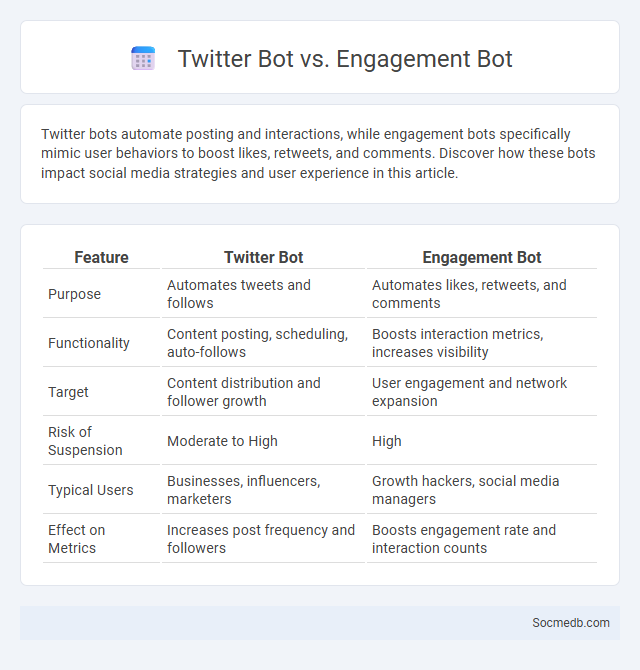
Photo illustration: Twitter Bot vs Engagement Bot
Twitter bots automate posting and interactions, while engagement bots specifically mimic user behaviors to boost likes, retweets, and comments. Discover how these bots impact social media strategies and user experience in this article.
Table of Comparison
| Feature | Twitter Bot | Engagement Bot |
|---|---|---|
| Purpose | Automates tweets and follows | Automates likes, retweets, and comments |
| Functionality | Content posting, scheduling, auto-follows | Boosts interaction metrics, increases visibility |
| Target | Content distribution and follower growth | User engagement and network expansion |
| Risk of Suspension | Moderate to High | High |
| Typical Users | Businesses, influencers, marketers | Growth hackers, social media managers |
| Effect on Metrics | Increases post frequency and followers | Boosts engagement rate and interaction counts |
Introduction to Social Media Bots
Social media bots are automated software programs designed to perform tasks such as posting content, liking, sharing, and following accounts on platforms like Twitter, Instagram, and Facebook. These bots can amplify marketing campaigns, manipulate public opinion, or spread misinformation by mimicking human behavior at scale. Understanding the mechanisms and impact of social media bots is essential for managing digital communication and combating online manipulation.
What is a Twitter Bot?
A Twitter bot is an automated software account that interacts with users, posts content, or performs tasks on Twitter without human intervention. These bots can be programmed to retweet, like, follow accounts, or send direct messages, often enhancing engagement or spreading information quickly. To optimize your Twitter experience, understanding how bots operate helps you identify genuine interactions versus automated activity.
What is an Engagement Bot?
An engagement bot is an automated software tool designed to interact with social media content by generating likes, comments, shares, or follows to boost visibility and user interaction. These bots mimic human behavior to enhance metrics, often manipulating algorithms that prioritize popular content. Understanding how an engagement bot functions can help you safeguard your social media presence from inauthentic interactions and potential penalties.
General Overview: What is a Bot?
A bot is an automated software application designed to perform specific tasks on social media platforms, such as posting content, liking, commenting, or following users. These programmed entities simulate human behavior to increase engagement, spread information, or even manipulate opinions. Understanding the role of bots can help you manage your online presence and maintain authentic interactions.
Key Differences: Twitter Bot vs Engagement Bot
Twitter bots automate content posting and follower interactions by simulating human behavior with tweets, retweets, and replies, primarily aimed at expanding reach and maintaining active presence. Engagement bots focus specifically on boosting metrics such as likes, comments, and shares to increase user visibility and perceived popularity on social media platforms. Your choice between a Twitter bot and an engagement bot should depend on whether your goal is broad content dissemination or targeted user interaction enhancement.
Use Cases for Twitter Bots
Twitter bots automate tasks such as monitoring brand mentions, engaging with followers, and distributing content to increase your online presence efficiently. These bots analyze trends and hashtags in real-time, allowing you to target specific audiences with personalized messages. Leveraging Twitter bots enhances customer service by providing instant responses and gathering user feedback for improved social media strategies.
Common Uses of Engagement Bots
Engagement bots on social media are primarily utilized to automate interactions such as liking, commenting, and following to artificially boost visibility and perceived popularity. These bots help brands and influencers increase their reach by generating rapid engagement metrics that attract organic users. The use of engagement bots can significantly influence social media algorithms, enhancing content promotion but often at the expense of genuine audience interaction.
Pros and Cons of Using Bots
Using bots on social media can significantly boost engagement by automating tasks such as liking, commenting, and following, which helps increase brand visibility and saves time. However, reliance on bots risks damaging authenticity and trust, as automated interactions may be perceived as spam or lead to account suspension under platform policies. Furthermore, while bots enhance efficiency, they often lack genuine human emotion and context, potentially compromising meaningful user connections.
Risks and Ethical Considerations
Social media platforms expose users to significant risks such as data privacy breaches, cyberbullying, and misinformation spread, which can severely impact mental health and personal security. Ethical considerations revolve around the responsible handling of user data, transparent algorithms, and the prevention of harmful content to protect individual rights and societal well-being. Your awareness and cautious engagement are essential to navigate these complexities while maintaining digital safety.
Future Trends of Bots in Social Media
Social media bots are expected to evolve with advancements in AI, enhancing personalized interactions and automating customer service more efficiently. Future trends include the integration of conversational AI for real-time engagement, sophisticated sentiment analysis to tailor responses, and increased use in content curation and moderation. These developments will transform social media ecosystems by improving user experience and enabling brands to scale communication efforts seamlessly.
 socmedb.com
socmedb.com